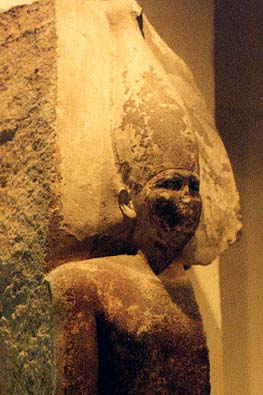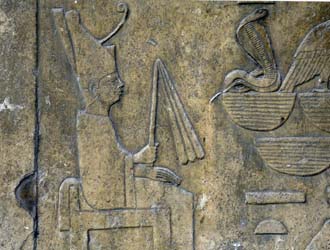King Snefru
Snefru (aka Sneferu) was the first pharaoh of the Fourth Dynasty,
during the Old Kingdom Period. His name meant “to make beautiful”. After
his death, the Egyptians remembered him as a good and just ruler. His
reign provided the basic labor structure his successor, Khufu, used to
build the Great Pyramid.
Family
 © JMCC1 - Statue of King Snefru
© JMCC1 - Statue of King SnefruSnefru is known to have married Hetepheres, the daughter of Huni. If Snefru was also the son of Huni, this means that he married his half sister, like several other famous Egyptian pharaohs. This practice was meant to solidify the king's claim to the throne.
Snefru had several children beside his heir, Khufu. Some scholars think that Snefru's first vizier, Prince Nefermaat, was also his son.
Egyptologists found a mastaba (tomb) for one of Snefru's sons near his Meidum pyramid. Some think that the pharaoh might have moved his capital after his son's death. Other mastabas belonging to Snefru's various children were founds in different graveyards, enabling scholars to compile a list of Snefru's children.
Reign
Snefru reigned for at least 24 years. During this time, he conducted military expeditions into Nubia and Libya. His goal was to get captives to increase his labor force. The raids also provided cattle and raw materials. He also received trade ships carrying cedar, likely from Lebanon, and mined turquoise and copper in the Sinai.His purpose was to finance his building projects and maintain a large workforce. In order to support this approach, he organized the country to allow for fewer people to produce food. He also developed methods for large scale quarrying and his builders learned how to make pyramids.
Snefru's reign was a time of experimentation. His builders worked with different pyramid building techniques to learn how to made a solid pyramid, while artists tried new ways of depicting images in tombs. Scholars have found tombs with some wall decorations painted on plaster and some carved into the walls. It seems the people were trying to determine which way would allow the images to last longer.
 © Juan R. Lazaro - Relief of King Snefru
© Juan R. Lazaro - Relief of King Snefru/////////////////////////////////////////////////////////////////////////////////////////////////
https://www.ancient-egypt-online.com/snefru.html
////////////////////////////////////////////////////////////////////////////////////////////////////////////////////////
No comments:
Post a Comment